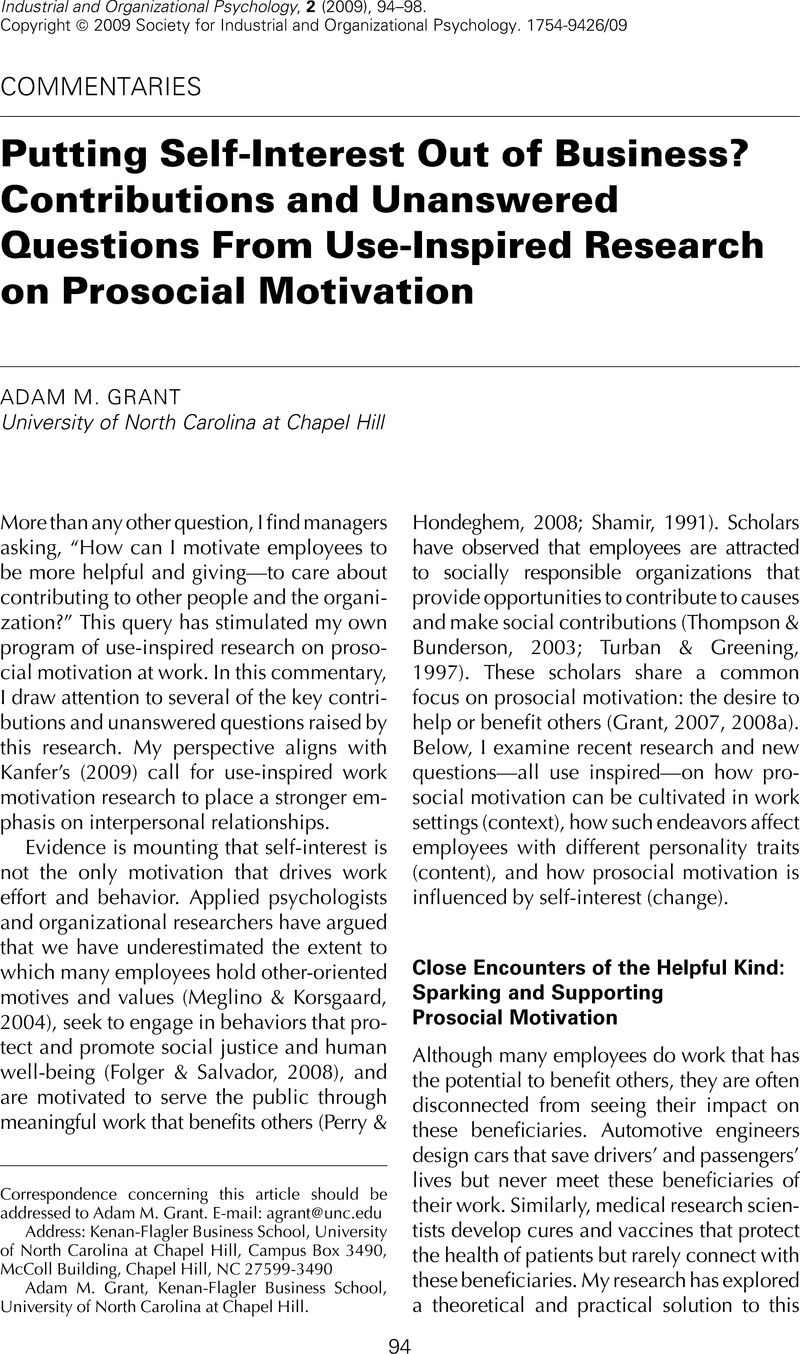Crossref Citations
This article has been cited by the following publications. This list is generated based on data provided by Crossref.
Kanfer, Ruth
2009.
Work Motivation: Advancing Theory and Impact.
Industrial and Organizational Psychology,
Vol. 2,
Issue. 1,
p.
118.
Twenge, Jean M.
Campbell, Stacy M.
Hoffman, Brian J.
and
Lance, Charles E.
2010.
Generational Differences in Work Values: Leisure and Extrinsic Values Increasing, Social and Intrinsic Values Decreasing.
Journal of Management,
Vol. 36,
Issue. 5,
p.
1117.
Dik, Bryan J.
Duffy, Ryan D.
and
Steger, Michael F.
2012.
Enhancing Social Justice by Promoting Prosocial Values in Career Development Interventions.
Counseling and Values,
Vol. 57,
Issue. 1,
p.
31.
Miller, Toyah L.
Grimes, Matthew G.
McMullen, Jeffery S.
and
Vogus, Timothy J.
2012.
Venturing for Others with Heart and Head: How Compassion Encourages Social Entrepreneurship.
Academy of Management Review,
Vol. 37,
Issue. 4,
p.
616.
Choi, Byoung Kwon
Moon, Hyoung Koo
and
Chun, Jae Uk
2015.
Impression management motive and voice: Moderating effects of self‐monitoring, self‐efficacy, and voice instrumentality.
Asian Journal of Social Psychology,
Vol. 18,
Issue. 3,
p.
225.
Tepper, Bennett J.
and
Simon, Lauren S.
2015.
Research in Personnel and Human Resources Management.
Vol. 33,
Issue. ,
p.
1.
Choi, Byoung Kwon
and
Moon, Hyoung Koo
2016.
Prosocial motive and helping behavior: examining helping efficacy and instrumentality.
Journal of Managerial Psychology,
Vol. 31,
Issue. 2,
p.
359.
Jain, Ajay K
2016.
Volunteerism, affective commitment and citizenship behavior.
Journal of Managerial Psychology,
Vol. 31,
Issue. 3,
p.
657.
Leheta, Dina
Dimotakis, Nikolaos
and
Schatten, Jeff
2017.
The view over one's shoulder: The causes and consequences of leader's envy of followers.
The Leadership Quarterly,
Vol. 28,
Issue. 3,
p.
451.
Abner, Gordon B.
Kim, Sun Young
and
Perry, James L.
2017.
Building Evidence for Public Human Resource Management: Using Middle Range Theory to Link Theory and Data.
Review of Public Personnel Administration,
Vol. 37,
Issue. 2,
p.
139.
Bastons, Miquel
Mas, Marta
and
Rey, Carlos
2017.
Pro-stakeholders motivation: Uncovering a new source of motivation for business companies.
Journal of Management & Organization,
Vol. 23,
Issue. 5,
p.
621.
Fritz, Claudia
and
van Knippenberg, Daan
2017.
Gender and leadership aspiration: Interpersonal and collective elements of cooperative climate differentially influence women and men.
Journal of Applied Social Psychology,
Vol. 47,
Issue. 11,
p.
591.
안정석
Joaram
and
Yeong-Ae Ku
2018.
A Study on the Effects of GRIT on Employment Motive and Employment Preparation Behavior of College Students Majoring in Dining and Culinary Art Education.
Journal of Employment and Career,
Vol. 8,
Issue. 4,
p.
73.
Shao, Danping
Zhou, Erhua
Gao, Peiran
Long, Lirong
and
Xiong, Jie
2019.
Double-Edged Effects of Socially Responsible Human Resource Management on Employee Task Performance and Organizational Citizenship Behavior: Mediating by Role Ambiguity and Moderating by Prosocial Motivation.
Sustainability,
Vol. 11,
Issue. 8,
p.
2271.
Schott, Carina
Neumann, Oliver
Baertschi, Muriel
and
Ritz, Adrian
2019.
Public Service Motivation, Prosocial Motivation and Altruism: Towards Disentanglement and Conceptual Clarity.
International Journal of Public Administration,
Vol. 42,
Issue. 14,
p.
1200.
Zhang, Hong
Chen, Kaiyuan
Schlegel, Rebecca
Hicks, Joshua
Chen, Changkai
Vazire, Simine
and
Inbar, Yoel
2019.
The Authentic Moral Self: Dynamic Interplay between Perceived Authenticity and Moral Behaviors in the Workplace.
Collabra: Psychology,
Vol. 5,
Issue. 1,
Bosch Rabell, Magdalena
and
Bastons, Miquel
2020.
Spirituality as reinforcement of people-focused work: a philosophical foundation.
Journal of Management, Spirituality & Religion,
Vol. 17,
Issue. 5,
p.
403.
Cohen, Nissim
and
Hertz, Uri
2020.
Street‐Level Bureaucrats’ Social Value Orientation On and Off Duty.
Public Administration Review,
Vol. 80,
Issue. 3,
p.
442.
Dragouni, Mina
and
McCarthy, Dermot
2021.
Museums as supportive workplaces: an empirical enquiry in the UK museum workforce.
Museum Management and Curatorship,
Vol. 36,
Issue. 5,
p.
485.
van Roekel, Henrico
and
Schott, Carina
2021.
Activating employees’ motivation to increase intentions to report wrongdoings: evidence from a large-scale survey experiment.
Public Management Review,
p.
1.





